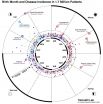(Press-News.org) NEW YORK, NY (June 8, 2015) - Columbia University scientists have developed a computational method to investigate the relationship between birth month and disease risk. The researchers used this algorithm to examine New York City medical databases and found 55 diseases that correlated with the season of birth. Overall, the study indicated people born in May had the lowest disease risk, and those born in October the highest. The study was published in the Journal of American Medical Informatics Association.
"This data could help scientists uncover new disease risk factors," said study senior author Nicholas Tatonetti, PhD, an assistant professor of biomedical informatics at Columbia University Medical Center (CUMC) and Columbia's Data Science Institute. The researchers plan to replicate their study with data from several other locations in the U.S. and abroad to see how results vary with the change of seasons and environmental factors in those places. By identifying what's causing disease disparities by birth month, the researchers hope to figure out how they might close the gap.
Earlier research on individual diseases such as ADHD and asthma suggested a connection between birth season and incidence, but no large-scale studies had been undertaken. This motivated Columbia's scientists to compare 1,688 diseases against the birth dates and medical histories of 1.7 million patients treated at NewYork-Presbyterian Hospital/CUMC between 1985 and 2013.
The study ruled out more than 1,600 associations and confirmed 39 links previously reported in the medical literature. The researchers also uncovered 16 new associations, including nine types of heart disease, the leading cause of death in the United States. The researchers performed statistical tests to check that the 55 diseases for which they found associations did not arise by chance.
"It's important not to get overly nervous about these results because even though we found significant associations the overall disease risk is not that great," notes Dr. Tatonetti. "The risk related to birth month is relatively minor when compared to more influential variables like diet and exercise."
The new data are consistent with previous research on individual diseases. For example, the study authors found that asthma risk is greatest for July and October babies. An earlier Danish study on the disease found that the peak risk was in the months (May and August) when Denmark's sunlight levels are similar to New York's in the July and October period.
For ADHD, the Columbia data suggest that around one in 675 occurrences could relate to being born in New York in November. This result matches a Swedish study showing peak rates of ADHD in November babies.
The researchers also found a relationship between birth month and nine types of heart disease, with people born in March facing the highest risk for atrial fibrillation, congestive heart failure, and mitral valve disorder. One in 40 atrial fibrillation cases may relate to seasonal effects for a March birth. A previous study using Austrian and Danish patient records found that those born in months with higher heart disease rates--March through June--had shorter life spans.
"Faster computers and electronic health records are accelerating the pace of discovery," said the study's lead author, Mary Regina Boland, a graduate student at Columbia. "We are working to help doctors solve important clinical problems using this new wealth of data."
INFORMATION:
The paper is titled, "Birth Month Affects Lifetime Disease Risk: A Phenome-Wide Method." The contributors are: Mary Regina Boland, Zachary Shahn, David Madigan, George Hripcsak, Nicholas P. Tatonetti (CUMC). Study link: http://jamia.oxfordjournals.org/content/early/2015/06/01/jamia.ocv046
The study was funded by grants from the National Institutes of Health (R01 GM107145 and R01 LM006910); the National Library of Medicine (T15 LM00707)
The authors declare no financial or other conflicts of interest.
Columbia University Medical Center provides international leadership in basic, preclinical, and clinical research; medical and health sciences education; and patient care. The medical center trains future leaders and includes the dedicated work of many physicians, scientists, public health professionals, dentists, and nurses at the College of Physicians and Surgeons, the Mailman School of Public Health, the College of Dental Medicine, the School of Nursing, the biomedical departments of the Graduate School of Arts and Sciences, and allied research centers and institutions. Columbia University Medical Center is home to the largest medical research enterprise in New York City and State and one of the largest faculty medical practices in the Northeast. For more information, visit cumc.columbia.edu or columbiadoctors.org.
The Data Science Institute at Columbia University, is training the next generation of data scientists and developing technology to serve society. http://datascience.columbia.edu/
NewYork-Presbyterian Hospital, based in New York City, is one of the nation's largest and most comprehensive hospitals and a leading provider of inpatient, ambulatory and preventive care in all areas of medicine. With some 2,600 beds and more than 6,500 affiliated physicians and 20,000 employees, NewYork-Presbyterian had more than 2 million visits in 2013, including close to 15,000 infant deliveries and more than 310,000 emergency department visits. NewYork-Presbyterian comprises six campuses: NewYork-Presbyterian/Weill Cornell Medical Center, NewYork-Presbyterian/Columbia University Medical Center, NewYork-Presbyterian/Morgan Stanley Children's Hospital, NewYork-Presbyterian/The Allen Hospital, NewYork-Presbyterian/Westchester Division and NewYork-Presbyterian/Lower Manhattan Hospital. The hospital is also closely affiliated with NewYork-Presbyterian/Hudson Valley Hospital and NewYork-Presbyterian/Lawrence Hospital. NewYork-Presbyterian is the #1 hospital in the New York metropolitan area, according to U.S. News & World Report, and consistently named to the magazine's Honor Roll of best hospitals in the nation. Affiliated with two world-renowned medical schools, Weill Cornell Medical College and Columbia University College of Physicians and Surgeons, NewYork-Presbyterian is committed to excellence in patient care, research, education and community service. For more information, visit http://www.nyp.org.
PROVIDENCE, R.I. [Brown University] -- Researchers from Brown University are developing a new algorithm to help robots better plan their actions in complex environments. It's designed to help robots be more useful in the real world, but it's being developed with the help of a virtual world -- that of the video game Minecraft.
Basic action planning, while easy for humans, is a frontier of robotics. Part of the problem is that robots don't intuitively ignore objects and actions that are irrelevant to the task at hand. For example, if someone asked you to empty the trashcan ...
Researchers at the University of Illinois at Urbana-Champaign have uncovered physical mechanisms allowing the manipulation of magnetic information with heat. These new phenomena rely on the transport of thermal energy, in contrast to the conventional application of magnetic fields, providing a new, and highly desirable way to manipulate magnetization at the nanoscale.
"In our study, we make use of the fact that a heat current passing through a magnetic material creates a separation of electron spins. This process creates a current of magnetic dipoles that we use to manipulate ...
DARIEN, IL - A new study suggests that increased restless legs syndrome (RLS) severity is associated with subsequent increased risk of stroke.
Results show that increased RLS severity is associated with subsequent increased risk of stroke, after considering other known risk factors such as age, smoking, hypertension, and unhealthy diet. There were 161 incident stroke cases during the six-year follow-up.
"We were surprised at the importance of taking into account RLS severity -- it was only severe RLS, not milder RLS, that was associated with increased risk of stroke," ...
DARIEN, IL - A new study suggests that lower life satisfaction is linked to sleep problems during midlife.
Respondents with higher life satisfaction reported shorter sleep onset latency (SOL). Sleep onset delay among those with low life satisfaction could be the result of worry and anxiety, as reported elsewhere. These findings support the idea that life satisfaction is interlinked with many measures of sleep and sleep quality, suggesting that improving one of these variables might result in improving the other.
"These findings support the idea that life satisfaction ...
URBANA, Ill. - Emerging adults aged 18 to 25 are often criticized for their poor interpersonal skills, sense of entitlement, and casual work ethic. But a new University of Illinois study suggests that fault-finding adult co-workers could make a big difference in young workers' leadership development by developing relationships with them, modeling the behaviors they wish to see, and providing leadership growth opportunities.
"Young adults in our study had learned a lot from mentors who modeled initiative, drive, and persistence; demonstrated how to communicate with confidence ...
DARIEN, IL - A new study suggests that children with traumatic brain injuries (TBI) have poorer sleep and more daytime sleepiness in comparison to healthy children.
Results show that children with TBI were more likely to experience greater daytime sleepiness, sleep disturbances and a poorer overall sleep quality. The children with TBI also had impaired emotional, physical and social functioning when compared to healthy children.
"We were surprised that children with a TBI experienced persistent increases in daytime sleepiness and decreases in sleep quality compared ...
A nuclear physicist and an archaeologist at the University of York have joined forces to produce a unique appraisal of the cultural significance of one of the world's most important locations for scientific inquiry.
In a paper published in the journal, Landscapes, Professor David Jenkins, of the Department of Physics at York, and Dr John Schofield, Head of the University's Department of Archaeology, have investigated CERN, the home of the Large Hadron Collider on the Franco-Swiss border.
Situated between the Jura Mountains and the Alps, CERN was established in 1954 to ...
This news release is available in German.
Material scientists at ETH Zurich and the Max Planck Institute of Colloids and Interfaces in Potsdam have developed a new type of sensor that can measure carbon dioxide (CO2). Compared with existing sensors, it is much smaller, has a simpler construction, requires considerably less energy and has an entirely different functional principle. The new sensor consists of a recently developed composite material that interacts with CO2 molecules and changes its conductivity depending on the concentration of CO2 in the environment. ...
Jackson Laboratory researchers have shown that using an electric current to deliver the CRISPR/Cas9 system, in order to engineer genetic changes in laboratory mice, is highly efficient and significantly improves the system's throughput.
CRISPR/Cas9 has significantly enhanced the precision, speed and ease with which experimental organisms can be genetically modified in order to create models of human diseases. Mice carrying mutations in single or multiple genes or other modifications can be created in one step by injecting the CRISPR/Cas9 system into zygotes (the cells ...
Metabolism experts are increasingly convinced that obesity and many of the pathogenic changes it entails, such as Metabolic Syndrome and type 2 diabetes, are a result of chronic inflammatory processes in fatty (adipose) tissue. The adipose tissue of obese people exhibits higher-than-normal quantities of almost all types of immune and inflammatory cells.
"We are quite convinced that immune cells play a role in the pathogenic consequences of obesity," says Professor Hans-Reimer Rodewald of the German Cancer Research Center (Deutsches Krebsforschungszentrum, DKFZ). "But ...




